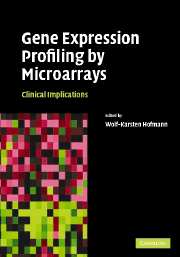Book contents
- Frontmatter
- Contents
- List of contributors
- Foreword
- Introduction
- 1 Technique of microarrays: microarray platforms
- 2 Quantitative quality control of microarray experiments: toward accurate gene expression measurements
- 3 Statistical analysis of gene expression data
- 4 Genomic stratification in patients with heart failure
- 5 Gene expression profiling for the diagnosis of acute leukemias
- 6 Gene expression profiling can distinguish tumor subclasses of breast carcinomas
- 7 Gene expression profiling in lymphoid malignancies
- 8 mRNA profiling of pancreatic beta-cells: investigating mechanisms of diabetes
- 9 Prediction of response and resistance to treatment by gene expression profiling
- Index
Introduction
Published online by Cambridge University Press: 05 September 2009
- Frontmatter
- Contents
- List of contributors
- Foreword
- Introduction
- 1 Technique of microarrays: microarray platforms
- 2 Quantitative quality control of microarray experiments: toward accurate gene expression measurements
- 3 Statistical analysis of gene expression data
- 4 Genomic stratification in patients with heart failure
- 5 Gene expression profiling for the diagnosis of acute leukemias
- 6 Gene expression profiling can distinguish tumor subclasses of breast carcinomas
- 7 Gene expression profiling in lymphoid malignancies
- 8 mRNA profiling of pancreatic beta-cells: investigating mechanisms of diabetes
- 9 Prediction of response and resistance to treatment by gene expression profiling
- Index
Summary
The development of methods to measure gene expression was revolutionized in the early 90th of the last century by Kary Banks Mullis who introduced the polymerase chain reaction (PCR). Total RNA was amplified using specific primers resulting in the detection of a gene specific PCR-product which could be visualized by gel electrophoresis. To detect specific gene expression in all different kinds of human cells, millions of PCR reactions were performed during the last 15 years. Today, PCR can be called a standard method for gene expression analysis which is used for diagnostic purpose as well as for analysis of physiological and pathophysiological gene expression in all organisms including humans.
Common PCR can help to detect the expression of single genes within one reaction. By optimizing the technique of PCR, the number of genes which can be detected within one reaction could be increased to a maximum of six by using fluorescence labeled primers or probes. High-throughput analysis of multiple genes, e.g., in hundreds of patients samples by PCR is very time consuming and requires a lot of technical and personell power. As a example, it would require about 625 days of work (24 hours a day) to analyze all the human genes which are known at this time by PCR using a singleplex reaction.
In 1995, Patrick O. Brown published the first paper about a new technique which could be used to simultaneously analyze gene expression of 45 genes within on experiment by using a microarray which was prepared by high-speed robotic printing of complementary DNA's on glass slides.
- Type
- Chapter
- Information
- Gene Expression Profiling by MicroarraysClinical Implications, pp. 1 - 7Publisher: Cambridge University PressPrint publication year: 2006



